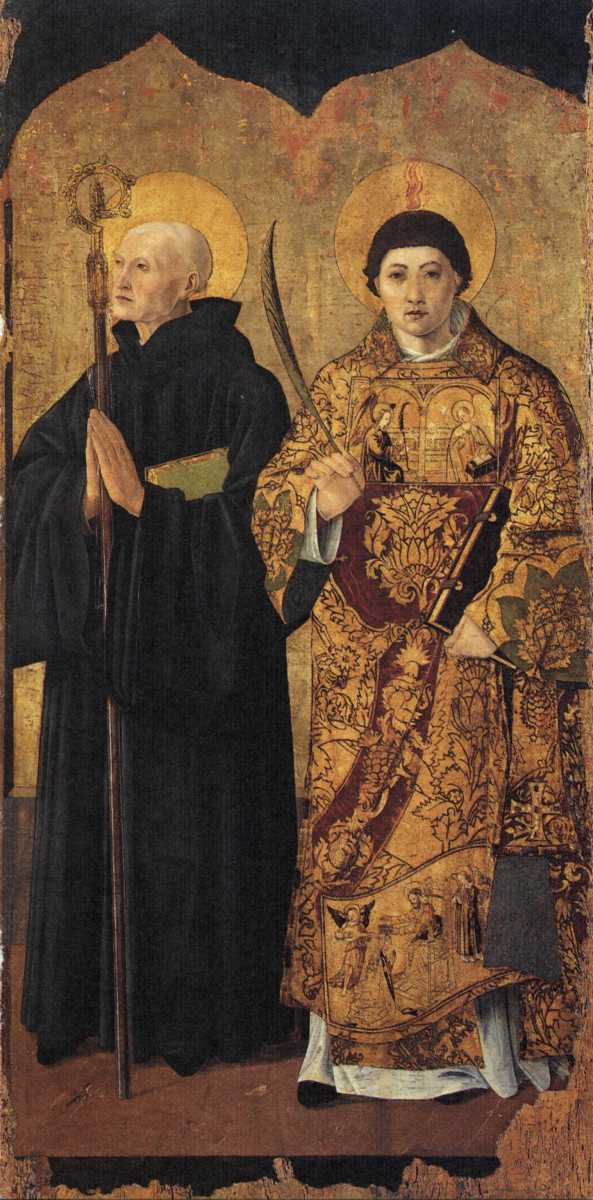Severinus is first recorded as travelling along the Danube in Noricum and Bavaria, preaching Christianity, procuring supplies for the starving, redeeming captives and establishing monasteries at Passau and Favianae, and hospices in the chaotic territories that were ravaged by the Great Migrations, sleeping on sackcloth and fasting severely.
Destruction from The Course of Empire, c. 1836
Oil on canvas
Height: 100.3 cm (39.5 in); Width: 161.2 cm (63.5 in)
New-York Historical Society
Thomas Cole (February 1, 1801 – February 11, 1848) was an English-born American painter known for his landscape and history paintings. One of the major 19th-century American painters, he is regarded as the founder of the Hudson River School, an American art movement that flourished in the mid-19th century. Cole's work is known for its romantic portrayal of the American wilderness. More on Thomas Cole
His efforts won him wide respect, including that of the Germanic chieftain Odoacer.
After a paintin of L.Kupelwieser
Odoaker meets the saint Severin
Engraving
Private collection
History roman antiquity - Odoacer (Odovacar)son of a scirian duque and leader of germanic mercenary soldiers.King of Rome 476-493 Odoaker meets the saint Severin.
Leopold Kupelwieser (17 October 1796, Markt Piesting – 17 November 1862, Vienna) was an Austrian painter, often associated with the Nazarene movement.
His talents were recognized at an early age by the time he was twelve, he was already attending the Academy of Fine Arts, Vienna.
During a stay in Rome in 1824, he came under the influence of Friedrich Overbeck and the Nazarene movement. He returned to Vienna and earned his living primarily as an illustrator and portrait painter.
In 1837, he became Professor of history painting at the Academy and, in 1850, was awarded the Knight's Cross of the Order of Franz Joseph. Virtually all of his later work involved religious altarpieces and frescoes. At the age of sixty he fell ill, apparently due to the rigors of painting on wet lime, and never recovered his health. More on Leopold Kupelwieser
Eugippius credits him with the prediction that Odoacer would become king of Rome. However, Severinus warned that Odoacer would rule not more than fourteen years.
St. Severinus of Noricum, c. 1879-81
Museo d'Arte Sacra, San Leo, Italy
The inscription means "St. Severinus, Abbot, Apostle of the Norici" – that is, of the people of "Noricum," a Roman province encompassing most of what are now Austria and Slovenia. The crozier in his right hand is the symbol of his authority as an abbot. He established a number of monasteries, which may explain the buildings in the background.
As for the St. Bernard dog at the saint's feet, no such animal is mentioned in Eugippius's definitive Life of St. Severin. More on this work
Ludovico Seitz (June 11, 1844 – January 18, 1908), also known as Ludwig Seitz, was an Italian painter.
Son of the German painter Alexander Maximilian Seitz (1811-1888), Ludovico adhered as his father to the Nazarene movement in painting. He executed the frescoes which decorate the German Chapel of the Basilica of Loreto (1892-1902), in panes with the stories of the Blessed Virgin. This is considered his most important work. He also executed frescoes in Santa Maria dell'Anima and in the Vatican and in the Djakovo cathedral in Croatia. He was director of the Pinacoteca Vaticana (part of the Vatican Museums). Among his students was Rosina Mantovani Gutti. More on Ludovico Seitz
Severinus also prophesied the destruction of Asturis, Austria, by the Huns under Attila. He established refugee centers for people displaced by the invasion, and founded monasteries to re-establish spirituality and preserve learning in the stricken region.
He died in his monastic cell at Favianae while singing Psalm 150. Six years after his death, his monks were driven from their abbey, and his body was taken to Italy, where it was at first kept in the Castel dell'Ovo, Naples, then eventually interred at the Benedictine monastery rededicated to him, the Abbey of San Severino in the city of Naples.
Please visit my other blogs: Art Collector, Mythology, Marine Art, Portrait of a Lady, The Orientalist, Art of the Nude and The Canals of Venice, Middle East Artists, 365 Saints, 365 Days, and Biblical Icons, also visit my Boards on Pinterest and my art stores at deviantart and Aaroko
Images are copyright of their respective
owners, assignees or others. Some Images may be subject to copyright
I don't own any of these images - credit is
always given when due unless it is unknown to me. if I post your images without
your permission, please tell me.
Ads are shown only to compensate the hosting
expenses.
If you enjoyed this post, please share with
friends and family.
Thank you for visiting my blog and also for
liking its posts and pages.
Please note that the content of this post
primarily consists of articles available from Wikipedia or other free sources
online.






No comments:
Post a Comment
Note: Only a member of this blog may post a comment.